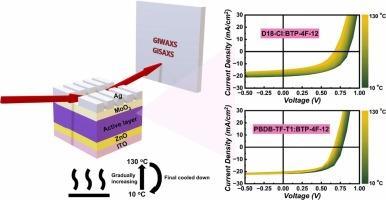基于 BTP-4F-12 的有机太阳能电池随温度变化的热行为
IF 17.1
1区 材料科学
Q1 CHEMISTRY, PHYSICAL
引用次数: 0
摘要
热量是导致性能下降的一个关键因素,这将导致活动层不可避免的形态变化。非原位表征的常见研究忽略了降解过程动力学,这阻碍了对有机太阳能电池(OSCs)潜在热降解机制的全面了解。在本研究中,利用掠入射宽/小角度x射线散射(GIWAXS/GISAXS)的operando跟踪研究了基于btp - 4f -12的太阳能电池的器件热稳定性,从而深入了解了温度依赖的降解过程。随着温度的升高,OSCs的开路电压(VOC)损失较大,但在冷却至低温后,VOC损失大多恢复。这种行为归因于载流子复合、π-π堆积距离和不同温度下的聚集域。老化过程中FF的不可逆损失和短路电流密度(JSC)是由于结晶度和密集π-π堆积的变化造成的。此外,在最终老化的太阳能电池中,FF的急剧下降没有发现明显的相关性,这表明这种降解不是由高温引起的,而更可能是由加热/冷却过程引起的。与PBDB-TF-T1:BTP-4F-12相比,PBDBTCl-DTBT:BTP-4F-12太阳能电池的热降解更严重,其中供体和受体的不良混溶性不利于优化稳定的活性层,聚合物供体的固有热性质也显著影响共混膜和太阳能电池的稳定性。该研究揭示了osc的温度依赖性热降解,拓宽了我们对常见的非原位表征的认识,加深了我们对热降解机制的理解。本文章由计算机程序翻译,如有差异,请以英文原文为准。

Temperature-dependent thermal behavior of BTP-4F-12-based organic solar cells
Heat is one key factor contributing to performance decreases, which would lead to inevitable morphological changes in the active layers. Common research with ex-situ characterizations ignored the degradation process kinetics, which hinders a comprehensive insight into the underlying thermal degradation mechanisms in organic solar cells (OSCs). In this study, the device thermal stability of BTP-4F-12-based solar cells is investigated with operando tracking of grazing-incidence wide/small-angle X-ray scattering (GIWAXS/GISAXS), providing a deep understanding of temperature-dependent degradation processes. The OSCs show a harsh open-circuit voltage (VOC) loss with increasing temperature, which recovers mostly after getting cooled to low temperature. This behavior is attributed to the charge carrier recombination, π-π stacking distances, and aggregated domains at various temperatures. The irreversible loss of FF and short-circuit current density (JSC) during aging is due to changes in crystallinity and dense π-π stacking. Furthermore, no obvious correlation is found for the sharp decreased FF for the final aged solar cells, suggesting that such a degradation originates not from high temperature but more likely from the heating/cooling process. PBDBTCl-DTBT:BTP-4F-12 solar cells suffer from a more severe thermal degradation compared with PBDB-TF-T1:BTP-4F-12, where the bad miscibility of donor and acceptor is not beneficial to an optimized stable active layer and the intrinsic thermal properties of the polymer donor also affect significantly the stability of the blend films and solar cells. This study reveals a temperature-dependent thermal degradation of OSCs, which broadens our knowledge from common ex-situ characterizations and deepens our understanding of thermal degradation mechanism.
求助全文
通过发布文献求助,成功后即可免费获取论文全文。
去求助
来源期刊

Nano Energy
CHEMISTRY, PHYSICAL-NANOSCIENCE & NANOTECHNOLOGY
CiteScore
30.30
自引率
7.40%
发文量
1207
审稿时长
23 days
期刊介绍:
Nano Energy is a multidisciplinary, rapid-publication forum of original peer-reviewed contributions on the science and engineering of nanomaterials and nanodevices used in all forms of energy harvesting, conversion, storage, utilization and policy. Through its mixture of articles, reviews, communications, research news, and information on key developments, Nano Energy provides a comprehensive coverage of this exciting and dynamic field which joins nanoscience and nanotechnology with energy science. The journal is relevant to all those who are interested in nanomaterials solutions to the energy problem.
Nano Energy publishes original experimental and theoretical research on all aspects of energy-related research which utilizes nanomaterials and nanotechnology. Manuscripts of four types are considered: review articles which inform readers of the latest research and advances in energy science; rapid communications which feature exciting research breakthroughs in the field; full-length articles which report comprehensive research developments; and news and opinions which comment on topical issues or express views on the developments in related fields.
 求助内容:
求助内容: 应助结果提醒方式:
应助结果提醒方式:


